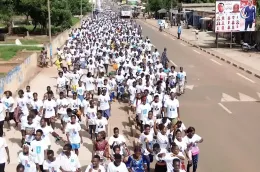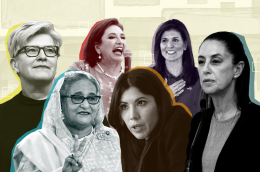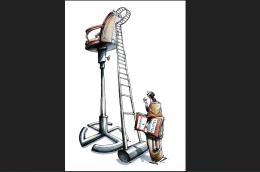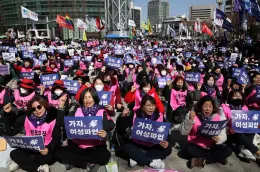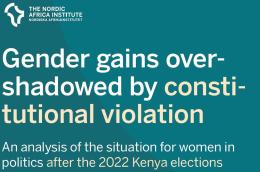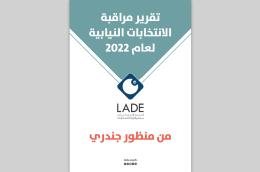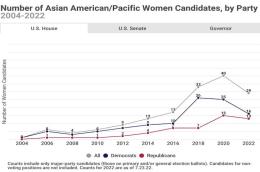Elections
Main navigation
Gender-based violence has crept up in the digital era in the form of online violence against women and girls, especially affecting women with political ambitions. Part of this violence entails gendered disinformation. This form of disinformation uses gender stereotypes to attack women and influence debates by promoting certain political, social or economic goals. It seeks to intimidate, discredit, humiliate and embarrass women, and push public debates.
According to Byte Bullies, a report by feminist think tank Pollicy, two out of five women candidates experienced sexual harassment on their X (formerly Twitter) accounts during the 2022 Kenyan general election. Added to this, 55.7 percent of Facebook accounts belonging to women candidates received some form of online violence compared to 35.4 percent for Facebook accounts of men candidates. Online violence manifested in the form of sexual harassment, hate speech, trolling, body-shaming and disinformation.
Seemingly, a woman’s personal life supersedes her résumé. “A closer look at the keyword network of sexual comments revealed underlying themes of comments attacking women’s appearance with words like “old” and “ass,” as well as themes of discouragement with words like “pathetic” and “nonsense.” Data also showed the two greatly targeted women candidates as being Anne Waiguru (who was vying for the position of governor for Kirinyaga County) and Martha Karua (2022 candidate for the position of deputy president.),” according to the Byte Bullies reports.
Read here the full article published by Global Voices on 25 April 2024.
Image by Global Voices
..
As Togo prepares for the legislative and regional elections on April 29, 2024, a significant number of women are in the electoral race, defying traditional norms and expectations.
With 2,348 validated candidacies for the legislative elections and 113 seats up for grabs, some 593 women are in the running for parliament and 438 women for the regional elections, according to figures obtained from the Independent National Electoral Commission.
Among these bold candidates are some remarkable personalities who aspire to bring a new perspective and more balanced representation to the political arena.
Such is the case of Victoire Dogbé, current Prime Minister of Togo and UNIR candidate. Touring the town of Vogan, she wooed voters by highlighting the work already accomplished and the importance of continuing along this path.
"We're ready to vote. And we need to cast a useful vote so that the work begun can continue," declared Dogbé at a campaign meeting on Sunday afternoon in the village of Klologo Gagnon.
Her political commitment has been hailed by citizens such as Adzovi Gati, a local farmer, who sees her as a guarantee for the future of Togolese women.
Read here the full article published by Africa News on 23 April 2024.
Image by Africa News
.
With more people set to vote in elections than at any time in history, 2024 is being touted as a test of democracies’ strength around the world, but one thing remains in noticeably short supply – female leadership candidates.
Analysis from the Guardian shows that of the 42 elections – both presidential and parliamentary – in which the country’s leader is being selected and where candidates have been declared, just 18 have women in the running to be leader. In just a handful of countries do women have a reasonable chance of winning – based on polling averages and the historical results of the parties they are running for.
With a combined population of more than two billion, elections in the world’s biggest democracies – the US, Indonesia and India – have, or had, no female frontrunners. The same is true of votes in the UK, Pakistan and South Africa.
Read here the full article published by The Guardian on 22 April 2024.
Image source: The Guardian
.
Phase 1 of the General Elections 2024 is over. There is still a long way to go before June 4 when the votes will be counted. Till then, we will be inundated with endless speculation, conjecture, guesses, accusatory statements by opposing sides — and the ritual photographs of women lining up to vote, holding aloft their election identity cards.
That image has become a cliché. But behind it is a story that has changed little, much like the photo itself. It is the story of Indian women and politics, why they are there, why they are missing, and whether anything will change in the near future.
Going by the candidates already in the fray this election, it seems as if change, if any, is incremental. Women constituted only 8% of the candidates in the first phase on April 19. This could change slightly by the end of the election cycle.
In the 2019 Lok Sabha elections, women were only 9% of the candidates. And fewer were elected. In fact, the success rate of women candidates was a little over 10% in 2019.
Also, although there were more women in the current Lok Sabha — 78 — than previously, they added up to only 14%. These low numbers contrast sharply with the increase in women voters. In 2019, their numbers were marginally more than that of men — 67.18% women compared to 67.01% men.
Read here the full article published by The Hindu on 19 April 2024.
Image by The Hindu
.
SEOUL, South Korea – When South Koreans elect a new parliament this week, the outcome will shape the next four years of the country's politics. But some watchers will be looking to verify a trend that can influence it for decades to come – the political divide between young men and women.
In the 2022 presidential election, 59% of male voters between ages 18 and 29 voted for the conservative candidate Yoon Suk Yeol, who eventually won. Their support for Yoon was second only to that of voters aged 60 and older.
By contrast, young women under 30 were the least supportive constituents for Yoon of all gender-age groups. Only 34% voted for him, according to exit polls.In recent major elections, young South Korean men and women have consistently shown around 15 to 30 percentage points' difference in their support of the main political parties.
While many other developed countries – including the United States, Germany and the United Kingdom – are observing a similar phenomenon, experts say South Korea's fast social development and politicization of gender issues have made its case particularly intense.
Read here the full article published by NPR on 10 April 2024.
Image by NPR
Welcome to the Knight Center’s new free online course, “Freedom of Expression, Artificial Intelligence and Elections,” organized by the Knight Center for Journalism in the Americas, in collaboration with UNESCO, UNDP, and with support of the Electoral Assistance Division (EAD) of the Department of Political and Peacebuilding Affairs (DPPA).
During this four-week massive open online course, which will be held during the month of April 2024, students will learn and explore the fascinating and ever-evolving world of technology and democracy, in particular on the impact of Artificial Intelligence on freedom of expression in elections.
To register for the course please follow these steps:
- Create an account in the Journalism Courses system. Even if you’ve taken a course with us before, you may need to create a new account. Check to see if your previous username and password work before creating a new account.
- Wait for a confirmation in your email indicating that your account has been created. If you do not receive this, please check your spam folder.
- Once your account is created and confirmed, please click on the following link to enroll: https://www.kccourses.org/enrol/index.php?id=121.
- Click “Enroll” to enroll yourself in the course. You will be able to access the course from the “My Courses” menu at the top of the page.
- Upon completing your enrollment, you will gain immediate access to the course and receive a confirmation email as well.
Who can enroll?
- Electoral practitioners and regulators.
- Journalists and media professionals.
- Civil society organizations working on elections, human rights, and gender equality.
- Students and educators.
- Voters and citizens interested in understanding AI and its impact on democracy.
To register for the course, click here.

